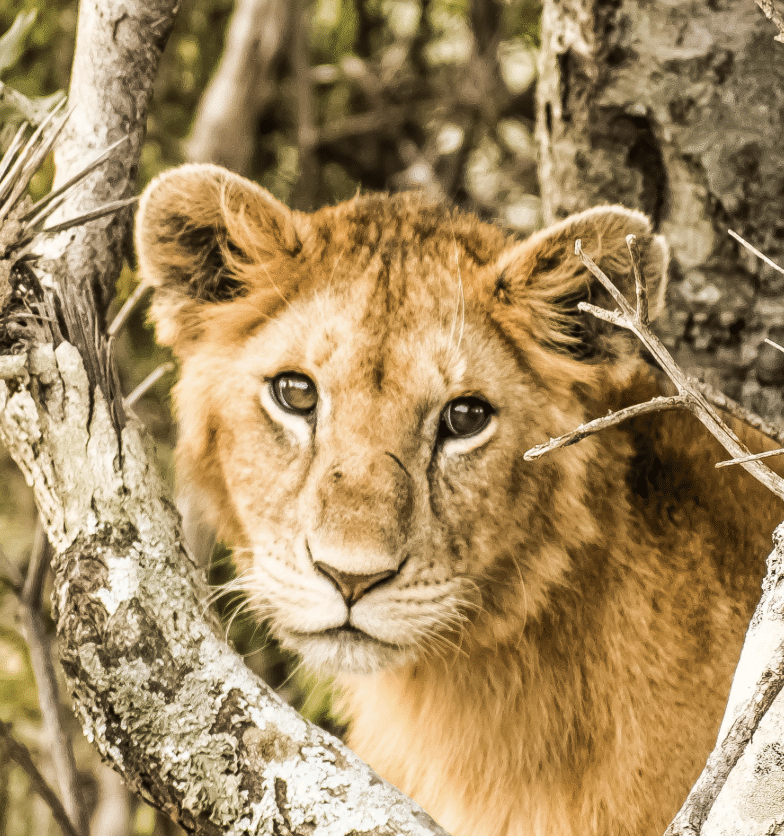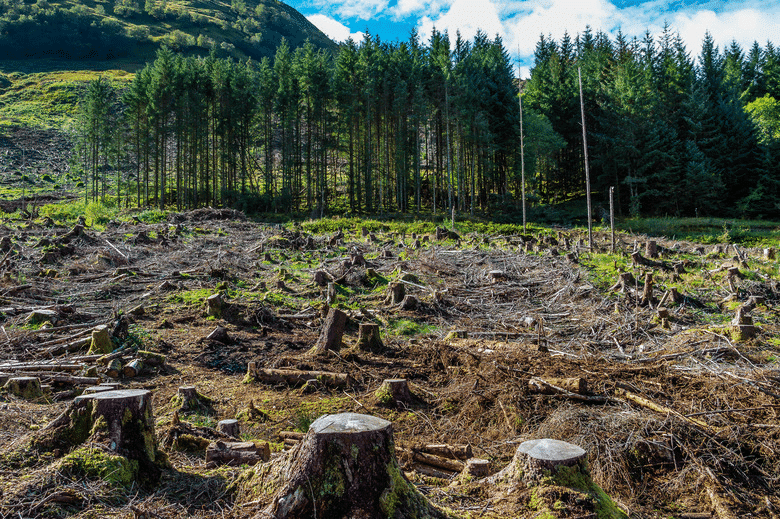Class 8 Science - Conservation of Plants and Animals CBSE Worksheets Solutions
| Table of contents |

|
| Multiple Choice Questions (MCQs) |

|
| Fill in the Blanks |

|
| True/False |

|
| Very Short Answer Questions |

|
Multiple Choice Questions (MCQs)
Q1: What is a primary cause of deforestation?
A) Increased rainfall
B) Building factories
C) Planting more trees
D) Decreased carbon dioxide levels
Ans. B) Building factories
Sol: Deforestation primarily occurs due to human activities such as building factories, expanding agricultural land, urbanization, and infrastructure development. These activities involve clearing forests, which leads to a reduction in forest cover.
Q2: Which of the following is a consequence of deforestation?
A) Lowered groundwater levels
B) Increased soil fertility
C) Decreased carbon dioxide levels
D) More rainfall
Ans. A) Lowered groundwater levels
Sol: Deforestation reduces the number of trees that help in maintaining the water cycle. This leads to less water infiltration into the soil, lowering groundwater levels.
 Q3: What is the purpose of a Wildlife Sanctuary?
Q3: What is the purpose of a Wildlife Sanctuary?
A) Encouragement of hunting and poaching
B) Protection of animal habitats
C) Promotion of tree felling
D) Allowing extensive human activity
Ans. B) Protection of animal habitats
Sol: The purpose of a Wildlife Sanctuary is to provide a safe and protected environment for animals and their habitats. It helps conserve biodiversity by restricting human activities like hunting, poaching, and deforestation within its boundaries.
Q4: What does the term "flora" refer to?
A) Animal life in a region
B) Types of soil
C) Plant life in a region
D) Water bodies
Ans. C) Plant life in a region
Sol: The term "flora" refers to the plant life found in a particular region or ecosystem. It includes all types of vegetation such as trees, shrubs, grasses, and other plants specific to that area.

Q5: The phenomenon of animals moving from one place to another in search of food or habitat is called:
A) Moving
B) Migration
C) Traveling
D) Relocating
Ans. B) Migration
Sol: Migration is the phenomenon where animals move from one place to another, often seasonally, in search of food, better living conditions, or breeding grounds. Examples include birds migrating to warmer regions during winter or fish like salmon migrating to spawn.

Fill in the Blanks
Q1: Deforestation increases the temperature level and pollution on Earth.
Q2: Desertification results in soil losing its moisture and fertility.
Q3: National Parks aim to preserve flora, fauna, and natural landscapes.
Q4: Endemic species are those species that are found exclusively in a particular area.

Q5: The Red Data Book keeps track of endangered species globally.
True/False
Q1: Reforestation involves the natural replenishment of deforested areas without human intervention.
Ans. False
Sol: Reforestation typically involves human efforts like planting trees and taking measures to restore a deforested area.
Q2: Cutting down trees does not affect the soil's physical properties.
Ans. False
Sol: Cutting down trees leads to deforestation, which exposes the soil to erosion by wind and water.
Q3: Paper can be recycled to save trees and reduce waste.
Ans. True
Sol: Recycling paper reduces the demand for new paper production, which, in turn, decreases the number of trees being cut down.

Q4: Biodiversity refers only to the variety of plants in an area.
Ans. False
Sol: Biodiversity encompasses the variety of all living organisms, including plants, animals, microorganisms, and their ecosystems.
Q5: Wildlife sanctuaries allow for activities like grazing and cultivation.
Ans. False
Sol: Wildlife sanctuaries are protected areas established to conserve wildlife and their natural habitats. Activities like grazing and cultivation are generally prohibited as they can disrupt the ecosystem and threaten the survival of the species being protected.
Very Short Answer Questions
Q1: Which gas is predominantly responsible for global warming?
Ans. CO2 (carbon dioxide)
Q2: Protected forests are also not completely safe for wild animals. Why?
Ans. Protected forests are also not completely safe for wild animals because people living in the neighbourhood encroach upon them and destroy them.
Q3: What is desertification?
Ans. Trees roots hold the soil in position and prevent soil erosion. Fewer trees result in more soil erosion. Removal of the top layer of the soil exposes the lower, hard and rocky layers. This soil has less humus and is less fertile. Gradually the fertile land gets converted into deserts. It is called desertification.

Q4: In order to meet the ever-increasing demand in factories and for shelter, trees are being continually cut. Is it justified to cut trees for such projects? Discuss and prepare a brief report.
Ans. No. Cutting trees in order to meet the ever growing demands of the human population is not at all justified. We depend on forests for our survival, from the air we breathe to the wood we use. Besides providing habitats for animals and livelihoods for humans, forests also offer watershed protection, prevent soil erosion and mitigate climate change.
Yet, despite our dependence on forests, we are still allowing them to disappear. Cutting of trees in order to meet the ever-increasing demand in factories and for shelter, trees will lead to global warming, soil erosion, greenhouse effect, droughts, floods, desertification etc. The destruction of forests will disturb the balance of nature. Hence, forests must be conserved.
Q5: What are the causes and consequences of deforestation?
Ans.
Causes of deforestation
- Forests are cut down to obtain more agricultural land.
- Forests shrink to a great extent to meet the requirements like for construction of roads, development of houses, mineral exploitation and expansion of industries.
- Forests are cut down to obtain wood for making paper.
- Forests are cut down to obtain wood for firewood and for making doors, windows and furniture.
- Natural factors such as forest fires and drought also causes deforestation.
Consequences of deforestation
- Deforestation will cause an increase in temperature of earth’s atmosphere leading to global warming.
- Deforestation disturbs the water cycle and may reduce rainfall. This could cause droughts.
- Deforestation leads to the change in soil properties and leads to desertification.
- Deforestation leads to extinction of many wild animals and plants.
- Deforestation also leads to a decrease in the water holding capacity of the soil. This could cause floods.
Q6: Name two national parks.
Ans. Corbett National Park (Uttarakhand) and Gir National Park (Gujarat)
Q7: What are the protected areas which have been earmarked to protect our flora and fauna and their habitats?
Ans. To protect our flora and fauna and their habitats, protected areas called sanctuaries, national parks and biosphere reserves have been earmarked.
Q8: Explain how deforestation leads to reduced rainfall.
Ans. Plants need carbon dioxide for photosynthesis. Fewer trees would mean that less carbon dioxide will be used up resulting in its increased amount in the atmosphere. This will lead to global warming as carbon dioxide traps the heat rays reflected by the earth. The increase in temperature on the earth disturbs the water cycle and may reduce rainfall. This could cause droughts.
Q9. What do you mean by wildlife?
Ans. Wildlife means all organisms that grow or live wild in an area without being introduced by humans.

Q10. Name some species which are endemic to Pachmarhi Biosphere Reserve.
Ans. Sal and wild mango are two examples of the endemic flora of the Pachmarhi Biosphere Reserve. Bison, Indian giant squirrel and flying squirrel are endemic fauna of this area.
|
90 videos|273 docs|44 tests
|
FAQs on Class 8 Science - Conservation of Plants and Animals CBSE Worksheets Solutions
| 1. How can we contribute to the conservation of plants and animals? |  |
| 2. What are the main threats to plants and animals conservation? |  |
| 3. How do national parks and wildlife sanctuaries help in the conservation of plants and animals? |  |
| 4. How does deforestation impact the conservation of plants and animals? |  |
| 5. What role do zoos and botanical gardens play in the conservation of plants and animals? |  |



















